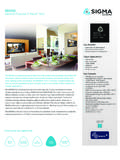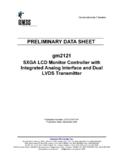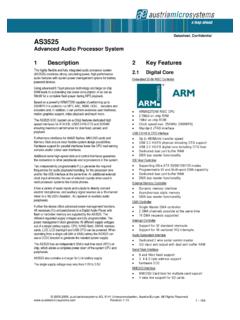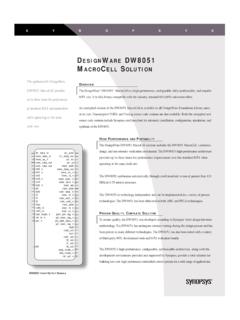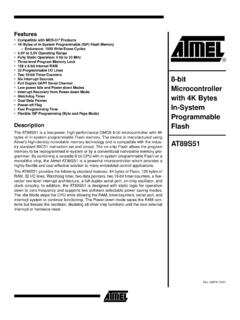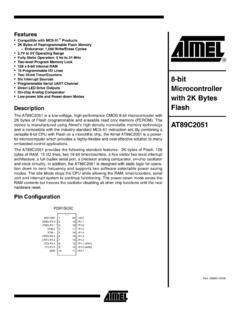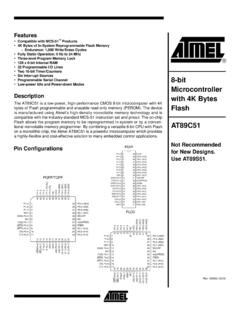Transcription of GettingStarted - Keil
1 UnitedStates:150110thStreet,Suite110 Plano,Texas75074 USAP hone +19723121107 FAX +19723121159 Europe:BretonischerRing1685630 GrasbrunnGermanyPhone +4989/456040-20 FAX +4989 Preface Information in this document is subject to change without notice and does not represent a commitment on the part of the manufacturer. The software described in this document is furnished under license agreement or nondisclosure agreement and may be used or copied only in accordance with the terms of the agreement. It is against the law to copy the software on any medium except as specifically allowed in the license or nondisclosure agreement. The purchaser may make one copy of the software for backup purposes. No part of this manual may be reproduced or transmitted in any form or by any means, electronic or mechanical, including photocopying, recording, or information storage and retrieval systems, for any purpose other than for the purchaser s personal use, without written permission.
2 Copyright 1997-2009 ARM Ltd and ARM Germany GmbH. All rights reserved. Keil, the Keil Software Logo, Vision, MDK-ARM, RL-ARM, ULINK, and Device Database are trademarks or registered trademarks of ARM Ltd, and ARM Inc. Microsoft and Windows are trademarks or registered trademarks of Microsoft Corporation. NOTE This manual assumes that you are familiar with Microsoft Windows and the hardware and instruction set of the ARM7 and ARM9 processor families or the Cortex -M series processors. In addition, basic knowledge of Vision 4 is anticipated. Every effort was made to ensure accuracy in this manual and to give appropriate credit to persons, companies, and trademarks referenced herein. getting started : Building Applications with RL-ARM 3 Preface This manual is an introduction to the Real-Time Library (RL-ARM ), which is a group of tightly coupled libraries designed to solve the real-time and communication challenges of embedded systems based on ARM processor-based microcontroller devices.
3 Using This Book This book comes with a number of practical exercises that demonstrate the key operating principles of the RL-ARM. To use the exercises you will need to have both the Keil Microcontroller Development Kit (MDK-ARM ) installed and the Real-Time Library (RL-ARM). If you are new to the MDK-ARM, there is a separate getting started guide, which will introduce you to the key features. The online documentation for the MDK-ARM, including the getting started guide, is located at Alongside the standard RL-ARM examples, this book includes a number of additional examples. These examples present the key principles outlined in this book using the minimal amount of code. Each example is designed to be built with the evaluation version of the MDK-ARM. If this is not possible, the example is prebuilt so that it can be downloaded and run on a suitable evaluation board. This book is useful for students, beginners, advanced and experienced developers alike.
4 However, it is assumed that you have a basic knowledge of how to use microcontrollers and that you are familiar with the instruction set of your preferred microcontroller. In addition, it is helpful to have basic knowledge on how to use the Vision Debugger & IDE. 4 Preface Chapter Overview Chapter 1. Introduction , provides a product overview, remarks referring to the installation requirements, and shows how to get support from the Keil technical support team. Chapter 2. Developing with an RTOS , describes the advantages of the RTX, explains the RTX kernel, and addresses RTOS features, such as tasks, semaphores, mutexes, time management, and priority schemes. Chapter 3. RL-Flash Introduction , describes the features of the embedded file system, how to set it up, configuration options, standard routines used to maintain the file system, and how to adapt flash algorithms. Chapter 4. RL-TCPnet Introduction , describes the network model, TCP key features, communication protocols, and how to configure an ARM processor-based microcontroller to function with HTTP, Telnet, FTP, SMTP, or DNS applications.
5 Chapter 5. RL-USB Introduction , describes the USB key features, the physical and logical network, pipes and endpoints, the device communication descriptors, and the supported interfaces and their classes. Chapter 6. RL-CAN Introduction , describes the CAN key concepts, the message frame, and the programming API implemented. getting started : Building Applications with RL-ARM 5 Document Conventions Examples Description Bold capital text is used to highlight the names of executable programs, data files, source files, environment variables, and commands that you can enter at the command prompt. This text usually represents commands that you must type in literally. For example: DIR Courier Text in this typeface is used to represent information that is displayed on the screen or is printed out on the printer This typeface is also used within the text when discussing or describing command line items. Variables Text in italics represents required information that you must provide.
6 For example, projectfile in a syntax string means that you must supply the actual project file name Occasionally, italics are used to emphasize words in the text. Elements that Ellipses (..) are used to indicate an item that may be repeated Omitted code .. Vertical ellipses are used in source code listings to indicate that a fragment of the program has been omitted. For example: void main (void) { .. while (1); Optional Items Double brackets indicate optional items in command lines and input fields. For example: C51 PRINT filename { opt1 | opt2 } Text contained within braces, separated by a vertical bar represents a selection of items. The braces enclose all of the choices and the vertical bars separate the choices. Exactly one item in the list must be selected. Keys Text in this sans serif typeface represents actual keys on the keyboard. For example, Press F1 for help.}
7 Underlined text Text that is underlined highlights web pages. In some cases, it marks email addresses. 1It is not required to enter commands using all capital letters. 6 Content Content Preface .. 3 Document Conventions .. 5 Content .. 6 Chapter 1. Introduction .. 10 RL-ARM Overview .. 10 RTX RTOS .. 11 Flash File System .. 11 TCP/IP .. 12 USB .. 12 CAN .. 13 Installation .. 14 Product Folder Structure .. 14 Last-Minute Changes .. 15 Requesting Assistance .. 15 Chapter 2. Developing With an RTOS .. 16 getting started .. 16 Setting-Up a Project .. 17 RTX Kernel .. 19 Tasks .. 19 Starting RTX .. 21 Creating Tasks .. 22 Task Management .. 24 Multiple Instances .. 24 Time Management .. 24 Time Delay .. 25 Periodic Task Execution .. 26 Virtual Timer .. 26 Idle Demon .. 27 Inter-Task Communication .. 28 Events .. 28 RTOS Interrupt Handling .. 29 Task Priority Scheme.
8 31 Semaphores .. 32 Using Semaphores .. 34 Signaling .. 34 Multiplex .. 34 getting started : Building Applications with RL-ARM 7 Rendezvous .. 35 Barrier Turnstile .. 36 Semaphore Caveats .. 38 Mutex .. 38 Mutex Caveats .. 39 Mailbox .. 39 Task Lock and Unlock .. 43 Configuration .. 43 Task Definitions .. 44 System Timer Configuration .. 45 Round Robin Task Switching .. 45 Scheduling Options .. 45 Pre-emptive Scheduling .. 46 Round Robin Scheduling .. 46 Round Robin Pre-emptive Scheduling .. 47 Co-operative Multitasking .. 47 Priority Inversion .. 47 Chapter 3. RL-Flash Introduction .. 49 getting started .. 49 Setting-Up the File System .. 50 File I/O Routines .. 52 Volume Maintenance Routines .. 54 Flash Drive Configuration .. 56 Adapting Flash Algorithms for RL-Flash .. 58 MultiMedia Cards .. 60 Serial Flash .. 62 Chapter 4. RL-TCPnet Introduction .. 63 TCP/IP Key Concepts .. 63 Network Model .. 63 Ethernet and IEEE.
9 65 TCP/IP Datagrams .. 65 Internet Protocol .. 65 Address Resolution Protocol .. 66 Subnet Mask .. 67 Dynamic Host Control Protocol DHCP .. 68 Internet Control Message Protocol .. 68 Transmission Control Protocol .. 69 User Datagram 70 Sockets .. 70 First Project - ICMP PING .. 71 8 Content Debug Support .. 74 Using RL-TCPnet with RTX .. 74 RL-TCPnet Applications .. 76 Trivial File Transfer .. 76 Adding the TFTP Service .. 76 HTTP Server .. 77 Web Server Content .. 78 Adding Web 78 Adding HTML as C Code .. 79 Adding HTML with RL-Flash .. 81 The Common Gateway Interface .. 82 Dynamic HTML .. 82 Data Input Using Web Forms .. 84 Using the POST Method .. 84 Using the GET Method .. 87 Using JavaScript .. 88 AJAX Support .. 90 Simple Mail Transfer Client .. 94 Adding SMTP Support .. 94 Sending a Fixed Email Message .. 95 Dynamic Message .. 96 Telnet Server .. 98 Telnet Helper Functions .. 100 DNS Client.
10 101 Socket Library .. 102 User Datagram Protocol (UDP) Communication .. 103 Transmission Control Protocol (TCP) 105 Deployment .. 108 Serial Drivers .. 109 Chapter 5. RL-USB Introduction .. 111 The USB Protocol Key Concepts .. 111 USB Physical Network .. 111 Logical Network .. 112 USB Pipes And Endpoints .. 113 Interrupt Pipe .. 115 Isochronous Pipe .. 115 Bulk Pipe .. 115 Bandwidth Allocation .. 116 Device Configuration .. 117 Device Descriptor .. 118 Configuration Descriptor .. 119 getting started : Building Applications with RL-ARM 9 Interface Descriptor .. 120 Endpoint Descriptor .. 121 RL-USB .. 122 RL-USB Driver Overview .. 122 First USB Project .. 124 Configuration .. 124 Event Handlers .. 125 USB Descriptors .. 126 Class Support .. 127 Human Interface Device .. 128 HID Report Descriptors .. 128 HID Client .. 133 Enlarging the IN & OUT Endpoint Packet Sizes .. 134 Mass Storage .. 136 Audio Class .. 138 Composite Device.

